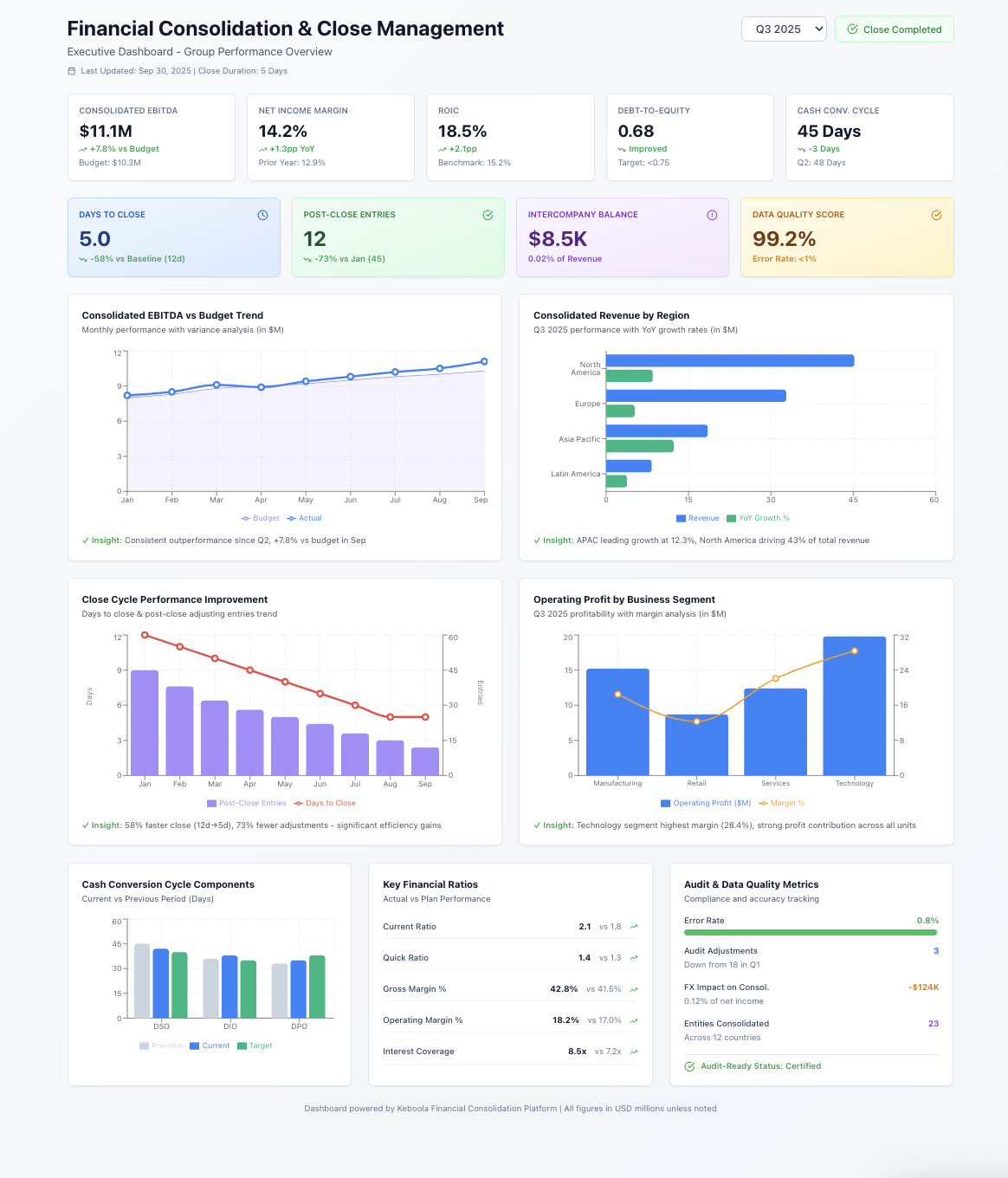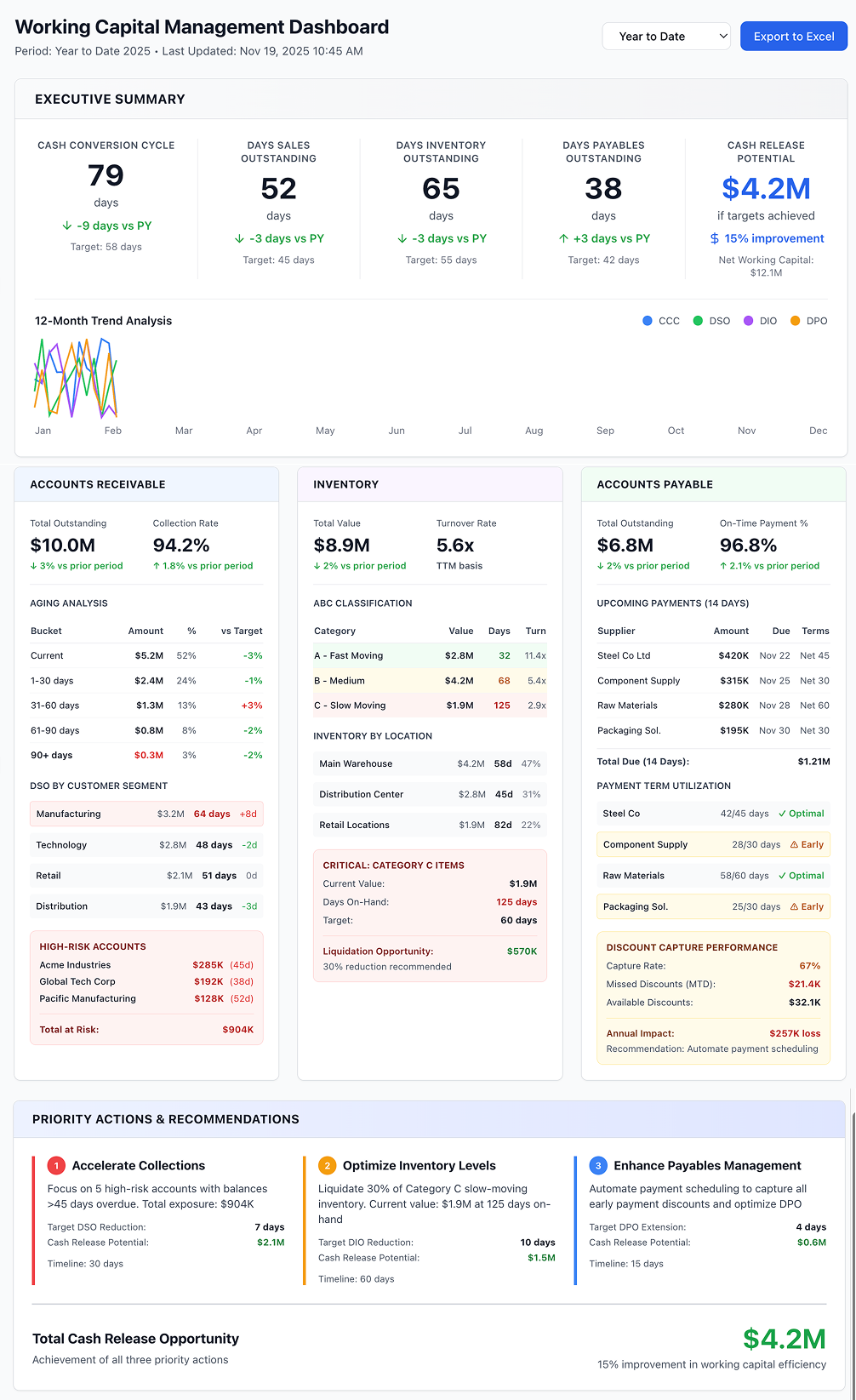Run your data operations on a single, unified platform.
- Easy setup, no data storage required
- Free forever for core features
- Simple expansion with additional credits

Thank you! Your submission has been received!
Oops! Something went wrong while submitting the form.

Request a Demo
Financial Consolidation & Close Management
Streamline multi-entity consolidation and cut the monthly close cycle in half.

Dashboard shown is a conceptual example. Keboola integrates with any BI or analytics platform.


Overview
This use case automates the aggregation of financial results across all subsidiaries and business units into unified, audit-ready statements. It’s designed for Group Finance teams and CFOs overseeing complex organizations with multiple ERPs and charts of accounts. By replacing manual spreadsheet consolidations with an integrated data platform, finance leaders gain real-time visibility into group performance. The process delivers faster consolidated P&Ls, balance sheets, and cash flows for decision-making, ensuring that the CFO can confidently report accurate results to executives and the board without late nights or last-minute adjustments. Seasoned finance professionals recognize this as the backbone of timely corporate reporting and a prerequisite for strategic agility.
Your Challenges

Lengthy, Error-Prone Close: Manual consolidation often involves chasing dozens of spreadsheets and reconciling entries by hand, a process that can drag on for weeks.

Data Silos & Inconsistent COAs: Different entities use disparate accounting systems and account structures, making it painful to standardize and map data.

Intercompany Reconciliation Bottlenecks: Intercompany transactions become a reconciliation nightmare in Excel. It’s common for finance staff to spend excessive time resolving discrepancies between entities

Audit & Compliance Risks: Lacking automation, every consolidation cycle carries risk of omitted eliminations or currency conversion mistakes.


Our Solution & Value

Automated Consolidation in Minutes
Keboola’s platform integrates all entities’ data and handles currency conversion, intercompany eliminations, and minority interest calculations automatically.

Single Source of Truth
A centralized data model harmonizes different ERP outputs into a consistent structure. This provides CFOs a certified view of performance across entities, eliminating the “multiple versions of the truth” problem.

Improved Data Quality & Auditability
With automated checks and data lineage, the consolidated results are transparent and error-free. Keboola ensures every adjustment or elimination has an audit trail.

Accelerated Decision Cycles
By freeing consolidation from manual drudgery, finance teams close 58% faster on average. Leadership gets timely reports and can make strategic decisions sooner.
What systems can you connect?
Example Outputs
[stakeholder] Group CFO
- Consolidated EBITDA vs. budget
- Group net income margin
- Cash conversion cycle (DSO/DPO/DIO)
- Return on invested capital (ROIC)
- Debt-to-equity ratio
[stakeholder] Group Controller
- Days to close (close duration)
- Number of post-close adjusting entries
- Intercompany out-of-balance amount
- FX impact on consolidation
- Audit adjustments identified (count)
[stakeholder] FP&A Manager
- Consolidated revenue growth by region
- Expense variance vs. last month
- Operating profit by segment
- Working capital % change
- Actual vs. plan financial ratios (e.g. current ratio)
FAQs
How quickly can we implement an automated consolidation for our complex structure?
Implementation is typically iterative. With Keboola’s pre-built connectors, many companies see initial consolidated reports within a few weeks. The platform’s flexibility means you don’t need to overhaul your ERPs – it adapts to your current systems. Most enterprise finance teams achieve a fully automated close in 2–3 months, significantly faster than traditional IT projects.
How does the solution handle multiple ERPs and different charts of accounts?
Keboola acts as a data hub, mapping each entity’s chart of accounts to a unified group taxonomy. It can pull data from SAP, Oracle, Microsoft Dynamics, and others, then standardize it. Local account codes and GAAP entries are preserved for entity-level detail, but the platform aligns them to group definitions for consolidation. This mapping is configurable and can evolve with your business (for example, if you add a new entity or change your accounting policies).
Will this help with audit and compliance?
Absolutely. All consolidation steps in Keboola are logged and transparent. You can provide auditors with a clear trail from reported financial statements back to source transactions. The platform supports segregation of duties and permissions (so, for instance, only authorized personnel can adjust consolidation entries). Companies have found that after implementation, audit reviews go much smoother – one customer reported error rates dropping below 1% in their financials, boosting audit confidence.
Related Use Cases
AI tools fail when they don’t connect to your real data or respect production workflows.































